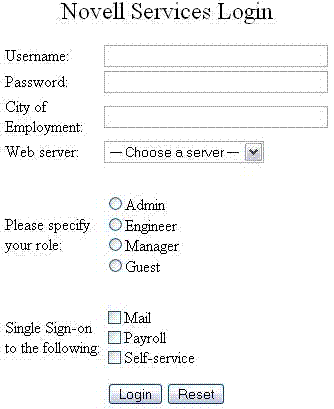14.1 Understanding an HTML Form
The following figure is an example of a Web page containing an HTML form.
Figure 14-1 Sample HTML Form

The information in this section uses this sample form to explain how to create a policy. This form deliberately contains a variety of field types:
-
Input items for Username and Password
-
Selection options for the Web server field
-
Radio buttons for the role
-
Check boxes for Single Sign-on
When analyzing a form, you need to decide if you want the policy to fill in all the fields or just some of them. You then need to look at the source HTML of the form to discover the names of the fields and their types.
14.1.1 Analyzing the HTML Form
An HTML form is created using a set of HTML tags. A form consists of elements (fields, menus, check boxes, radio buttons, push buttons, etc.) that control how the form is completed and submitted. For more detailed information about forms, see the Forms section at www.w3.org.
The following HTML data corresponds to the sample form (see Figure 14-1). The lines that contain the information needed to create a Form Fill policy appear in bold type. Each line corresponds to a field in the form that requires information or allows the user to select information.
<!DOCTYPE html PUBLIC "-//W3C//DTD HTML 4.01 Transitional//EN" "http://www.w3.org/TR/html4/loose.dtd"> <html> <head> <meta http-equiv="Content-Type" content="text/html; charset=UTF-8"> <title>iChain Form Test Page</title> </head> <body> <form name="mylogin" action="validatepassword.php" method="post" id="mylogin">
<table align="center" border="0" cellpadding="4" cellspacing="4">
<tr align="center" valign="top">
<td>
<p align="center"><font size="5">Novell Services Login</font></p>
<table align="center" border="0">
<tr align="left">
<td>Username:</td>
<td><input type="text" name="username" size="30"></td>
</tr>
<tr align="left">
<td>Password:</td>
<td><input type="password" name="password" size="30"></td>
</tr>
<tr align="left">
<td>City of<br>Employment:</td>
<td><input type="text" name="city" size="30"></td>
</tr>
<tr align="left">
<td>Web server:</td>
<td>
<select name="webserv" size="1">
<option value="default" selected>
--- Choose a server ---
</option>
<option value="Human Resources">
Human Resources
</option>
<option value="Development">
Development
</option>
<option value="Accounting">
Accounting
</option>
<option value="Sales">
Sales
</option>
</select>
</td>
</tr>
<tr>
<td colspan="2" align="left" height="25" valign="top">
<p></p>
</td>
</tr>
<tr align="left">
<td>Please specify<br>your role:</td>
<td>
<input name="role" value="admin" type="radio">Admin<br>
<input name="role" value="engineer" type="radio">Engineer<br>
<input name="role" value="manager" type="radio">Manager<br>
<input name="role" value="guest" type="radio">Guest
</td>
</tr>
<tr>
<td colspan="2" align="left" height="25" valign="top" width="121">
<p></p>
</td>
</tr>
<tr align="left">
<td>Single Sign-on<br>to the following:</td>
<td>
<input name="mail" type="checkbox">Mail<br>
<input name="payroll" type="checkbox">Payroll<br>
<input name="selfservice" type="checkbox">Self-service<br>
</td>
</tr>
</table>
</td>
</tr>
<tr>
<td colspan="2" align="center">
<input value="Login" type="submit">
<input type="reset">
</td>
</tr>
</table>
</form>
</body>
</html>
Each bold line contains information about a field, its name, and type. You use this information in the policy to specify how the information in the field is filled. For example, if you want the Username field filled in automatically, your Form Fill policy would have a line similar to the following:
<input type=”TEXT” name=”username” value="~cn">
The Username field would automatically be filled in with the value of the cn attribute of the user. If you want the users to enter their usernames the first time the form is accessed, your Form Fill policy would have a line similar to the following:
<input type=”TEXT” name=”username” value="~">
The next section explains how to use the tilde operator and tags to fill in values.